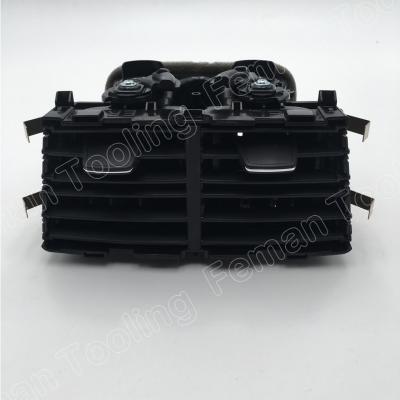Injection mold is a tool for producing plastic products and it is also a tool for giving plastic products a complete structure and precise size. The structure of the injection mold and mold processing quality directly affect the quality and production efficiency of plastic products.
Feman Tooling, a China 2k injection molding manufacturer, is a professional company that provides injection molding solutions and equipment.
The main reason for this failure is that the degree of finish of the taper hole of the pouring gate is poor, and there are knife marks around the circumference of the inner hole. The second is that the material is too soft, the small end of the taper hole is deformed or damaged after a period of usage, and that the curvature of the nozzle spherical surface is too small, causing the material around the pouring gate to generate the riveting head. The taper hole of the sprue bushing is very difficult to process, so standard parts should be used as much as possible. If you need to process it yourself, you should buy a special reamer or make one by yourself.
The guide pillar mainly plays a guiding role in the 2 component injection molding to ensure that the molding surfaces of the core and the cavity do not collide with each other under any circumstances. The guide pillar cannot be used as a force-bearing part or a positioning part.
In the following situations, the moving and fixed mold will produce a huge lateral deflection force when injecting:
(1) When the wall thickness of the plastic part is not even, the material flow rate is high at the thicker wall, so there will be greater pressure in this area;
(2) The side face of the plastic part is not symmetrical. For example, the back pressure on the opposite sides of the mold of the stepped parting surface is not equal.
Due to the different filling rates of each direction, and the influence of the weight of the injection molding mold during mold assembly, the displacement of the movable and fixed molds will occur. In the above cases, the lateral offset force will be added to the guide pillar during the injection. When opening the mold, if the surface of the guide pillar is roughed, damaged or in severe cases, the guidepost may be bent or cut off, and the mold cannot even be opened. In order to solve the above problems, a high-strength positioning key should be added to each of the four sides of the mold parting surface. The most simple and effective way is to use a cylindrical key.
When the mold is being injected, the molten plastic in the cavity produces huge backpressure. Mold makers sometimes do not pay attention to this problem, and often change the original design size, or replace the movable template with a low-strength steel plate. In the mold with ejector pins, the large seat span between the two sides will cause the template to bend during the injection.
Therefore, the movable template must be made of high-quality steel, with sufficient thickness. Low-strength steel plates such as A3 should not be used. When necessary, support columns or support blocks should be set under the movable template to reduce the thickness of the template and increase its load-bearing capacity. A reliable ABS plastic injection molding manufacturer will apply high-quality steel with sufficient thickness.
The cooling effect of the mold directly affects the quality and production efficiency of molded plastic products, such as defects like surface deformation resulting from poor cooling, large product shrinkage, or uneven shrinkage. On the other hand, the overall or partial overheating of the mold makes the mold unable to form normally and thus make the production stop. In severe cases, the movable parts such as the ejector rods will be damaged because they are thermally expanded and get stuck.
The design and processing of the cooling system depend on the shape of the product. Don't omit this system because of the complex structure of the mold or the difficulty of processing. Especially for large and medium-sized molds, the cooling problem must be fully considered.
